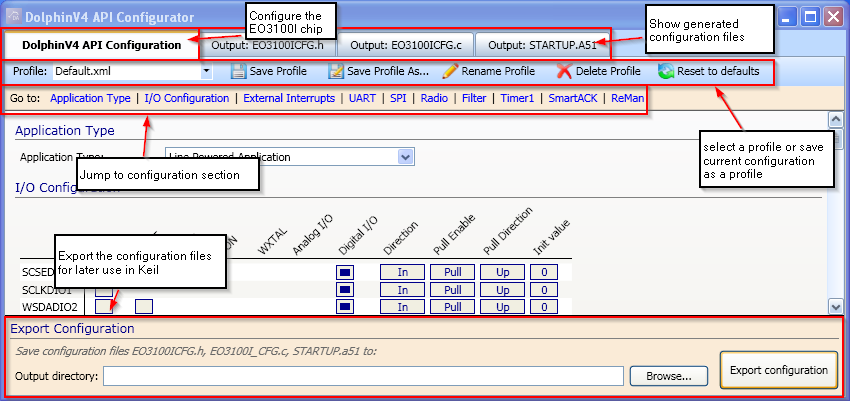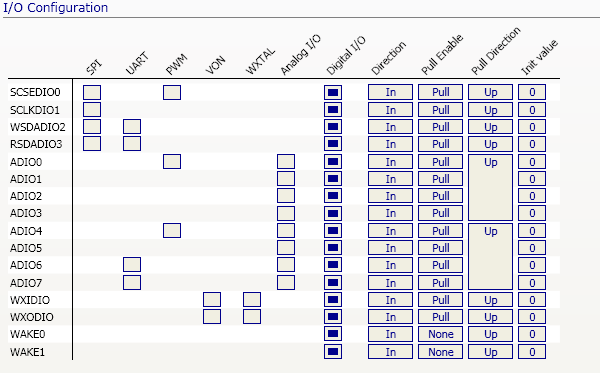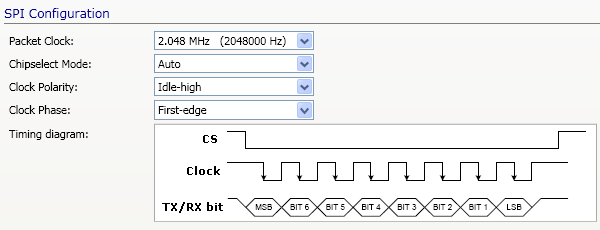DolphinV4 API Configurator
DolphinV4 API Configurator is used to configure the EO3100I chip and to generate the configuration files to include in Keil.
DolphinV4 API Configurator can be started directly from Keil. The advantage is that the generated files (EO3100I_CFG.h, EO3100I_CFG.c, STARTUP.A51) will be stored directly in your Keil project. You can also create project specific profiles and save them in your Keil project directory. To learn how to configure Keil for that purpose read section Configure Keil.
Configuration sections
Here you can see how to configure the EO3100I chip. To learn how to use the different functions please read the EO3100I_API Documentation.
Application Type
This page is used to select the type of the application. The type of application selects what kind of scheduler will be used in the EO3100I_API.
I/O Configuration
-
for interface configuration (SPI, UART, PWM, etc.) select the interface column checkboxes - note that according to the interface selection some additional configuration pages will be enabled or disabled
-
if a pin is configured as digital I/O select its direction by clicking on the Direction button
-
the Pull Enable column indicates whether the pin has pull up/down characteristics
-
the Pull Direction column indicates the direction of the pull characteristics
External Interrupts
Select pins for external interrupts IGE0, IGE1 or IGE2. You can choose the corresponding pin and if the interrupt is thrown on rising or on falling edge. For IGE2 you can choose an interrupt when VDD gets lower than VON.
UART
-
in the I/O configuration section select an UART interface from pins WSDADIO2+RSDADIO3 or ADIO6+ADIO7
-
select the correct baudrate
SPI
-
in the I/O configuration page select the SPI interface (pins SCSEDIO0,SCLKDIO,WSDADIO2,RSDADIO3)
-
note that the SPI interface is only MASTER
-
select the correct clock rate
-
select the correct CS mode
-
select the correct clock polarity/phase
Radio
-
select the number of telegram buffers, each buffer requires 30 bytes of XRAM so 10 buffers use 10*30 = 300bytes - optimal is the setting with 4 buffers
-
select the maturity time which is the upper limit for the telegram transmission duration, note that the default and intended value is 100, all other values should only be used for debugging purposes
-
if your application should work also as a repeater, select the repeater and its level (first-level repeater / second-level repeater)
For further information read the document EnOcean Radio Protocol (PDF).
Filter
-
select the logical connection between filter entries which automatically enables the filtering
-
select the number of filters - note each filter entry needs 5 bytes in the XRAM
Timer1
-
select the mode of the Timer1 module
-
PWM - in this mode the module/chip can generate a PWM signal on selected pins. Be sure to choose at least one of the PWM pins (SCSEDIO0/ADIO0/ADIO4) in the IO configuration page.
-
Counter/Callback - in this mode the timer1 is used as a HW counter. For this counter it is possible to define a callback function.
-
below you can adjust the timer1 Period and Postscaler settings
-
for PWM you can adjust the Active state settings
SmartACK
Here you can configure the Mailbox Count and the Mailbox Flash Address for the SmartACK functionality. To learn more about SmartACK functionality read the document Smart Acknowledge (PDF).
ReMan
Here you can enable/disable and configure the Remote Management module. To learn more about Remote Management please read the document Remote Management (PDF).











